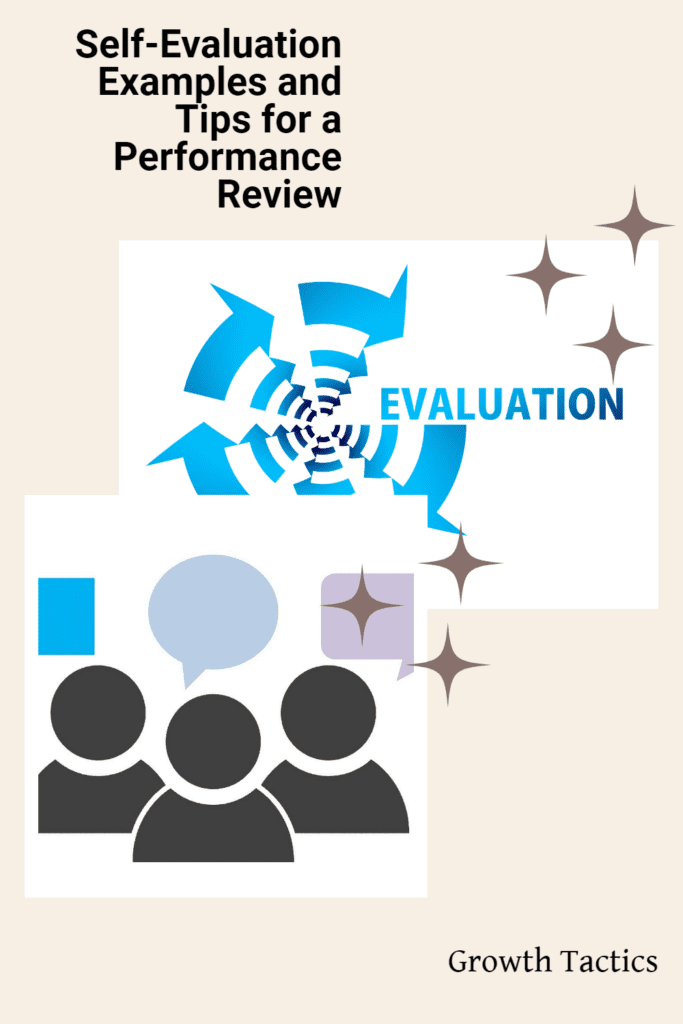Have you ever felt that knot in your stomach when it’s time to write your self-evaluation? I sure have. But after a decade as a manager, I’ve learned some secrets to make it easier.
Self-evaluations aren’t just paperwork, they’re your chance to shine! Think of it as your personal highlight reel. I’ve seen firsthand how a great self-assessment can open doors and spark amazing conversations with your boss.
In this article, we’ll dive into why these evaluations matter, and what to include, and I’ll even share some real-life examples.
Ready to turn that dreaded task into your secret weapon? Let’s do this!
Jump To Section
What is a Self-Assessment?
A self-assessment is a process of evaluating one’s performance, skills, and capabilities. It allows individuals to reflect on their strengths, weaknesses, accomplishments, and areas for improvement. Self-assessments provide an opportunity for self-reflection and self-awareness, enabling individuals to gain insights into their performance and identify areas where they can grow and develop.
During a self-assessment, individuals assess their performance against specific criteria, such as job responsibilities, goals, and competencies. They evaluate how well they have met expectations, whether they have achieved their stated objectives, and identify any gaps or areas where they may need support or development.
Self-assessments can be an integral part of performance management systems or used for personal development purposes. They can be conducted as part of a formal performance review process, where employees provide their self-assessment to supplement the evaluation conducted by their manager. Alternatively, individuals can undertake self-assessments independently to gain insights into their progress and determine areas for improvement.
The purpose of a self-assessment is to encourage self-reflection, take ownership of one’s performance, and set goals for growth and development. It enables individuals to identify their strengths and leverage them to excel in their roles, as well as pinpoint areas where improvement is needed. By understanding their strengths and weaknesses, individuals can take proactive steps to enhance their skills or acquire new ones.
Self-assessments also promote accountability and self-accountability. By critically evaluating their performance and setting goals, individuals take responsibility for their professional development and success. It demonstrates a proactive and growth-oriented mindset that contributes to personal and professional growth.
Overall, a self-assessment is a valuable tool for individuals to gain self-awareness, evaluate their performance, and set goals for improvement. It fosters continuous learning, self-improvement, and a proactive approach to professional development.
Why Write a Self-Evaluation?
Writing a self-evaluation allows you to reflect on your performance over time and identify areas for improvement. By reviewing your job description, setting goals, and thinking through your strengths and weaknesses, you’ll be better prepared to discuss your overall performance during your next review. Additionally, writing a self-assessment allows you to:
- Take control of your professional development
- Identify areas for growth and set goals accordingly
- Highlight your strengths and accomplishments
- Learn how to write constructive feedback
- Successfully communicate your needs and contributions to your manager
Tips for Writing a Self-Evaluation
To write a useful self-evaluation, keep the following tips in mind:
1. Review the Last Performance Review
Before writing your self-evaluation, review the last performance review you received. This will give you a sense of where you’ve made progress and where you might need to improve. If you received specific feedback or action items during your last review, be sure to address them in your self-evaluation.
2. Use Your Job Description
Your job description is a great resource for identifying the responsibilities and metrics that are most important for your role. Use it as a guide to help you identify your key performance indicators (KPIs) and assess how well you’ve performed in each area. Make sure to touch on each responsibility outlined in your job description.
3. Reflect on Your Performance Over Time
Your self-evaluation should cover your performance over the entire review period, not just the last few weeks or months. Think back to the beginning of the review cycle and consider how you’ve grown and developed in your role. Highlight your strengths and areas for improvement in each KPI, and provide specific examples of your accomplishments.
4. Identify Areas for Growth
No matter how well you’ve performed, there is always room for growth. Use your self-evaluation to identify areas where you would like to improve, and set goals that will help you get there. If there are resources you need to grow in your career, identify them so your manager can help you get what you need.
5. Be Collaborative
Your self-evaluation shouldn’t be a one-way conversation. By being collaborative and including specific examples of your work, you can help your manager understand your perspective. Additionally, by asking for feedback and input, you can work together to identify areas where you can improve or grow in your role.
What Should Be Included in a Self-Evaluation?
When writing a self-evaluation, it’s important to cover key aspects of your performance and provide a comprehensive assessment of your work. Here are some important elements to include in your self-evaluation:
1. Overall Performance
Reflect on your overall performance during the review period. Discuss your accomplishments, challenges, and growth in your role. Highlight any significant achievements and contributions you have made to the team or organization.
2. Job Responsibilities
Evaluate how well you have fulfilled your job responsibilities. Discuss how effectively you have executed your duties, met deadlines, and delivered results. Provide specific examples to support your assessment.
3. Goals and Objectives
Assess your progress in achieving the goals and objectives set for the review period. Discuss your accomplishments and any adjustments made along the way. If you faced any obstacles or encountered unexpected circumstances, explain how you managed them.
4. Skills and Competencies
Evaluate the skills and competencies that are relevant to your role. Discuss areas where you have excelled and areas where you would like to improve. Provide examples of how you have utilized your skills to contribute to projects or tasks.
5. Collaboration and Communication
Assess your collaboration and communication skills. Reflect on how well you have worked with others, contributed to a positive team dynamic, and effectively communicated information. Provide examples of successful collaborations or instances where you have demonstrated effective communication.
6. Strengths and Areas for Improvement
Identify and discuss your strengths and areas for improvement. Highlight your unique capabilities and how they have positively impacted your work. Be honest about areas where you could enhance your skills or knowledge. Suggest strategies and goals for addressing these areas.
7. Professional Development
Reflect on your commitment to professional growth and development. Discuss any training, courses, or workshops you have attended, as well as any new skills you have acquired. Share your aspirations for future growth and how you plan to enhance your professional development.
8. Self-Reflection and Feedback
Demonstrate your ability to reflect on feedback and learn from it. Discuss how you have incorporated feedback received from colleagues, clients, or supervisors. Emphasize your openness to constructive criticism and your commitment to continuous improvement.
By including these key elements in your self-evaluation, you will provide a comprehensive view of your performance, accomplishments, and areas for growth. Remember to be specific, provide examples, and focus on actionable goals for future development.
Best Practices for Writing a Self-Assessment
Writing a self-assessment can be a valuable opportunity to reflect on your performance and set goals for growth and development. Here are some best practices to consider when composing your self-assessment:
1. Be Honest and Objective
Provide an honest and objective evaluation of your performance. Acknowledge your strengths and accomplishments, but also be transparent about areas where you may have fallen short. Remember, the purpose of a self-assessment is to identify areas for improvement and set meaningful goals.
2. Use Specific Examples
Support your self-assessment with specific examples that demonstrate your accomplishments and contributions. Use concrete details and specific outcomes to highlight your successes and provide evidence of your capabilities. This will make your self-assessment more compelling and credible.
3. Align with Goals and Objectives
Refer back to your goals and objectives from the review period. Assess your progress in achieving them and highlight any milestones or accomplishments. If there were any challenges or adjustments along the way, mention how you managed them. This shows your commitment to meeting organizational expectations.
4. Seek Feedback
Consider gathering feedback from colleagues, clients, or supervisors to inform your self-assessment. Incorporate constructive feedback received throughout the review period and discuss how you have responded to it. This demonstrates your ability to learn from feedback and your commitment to personal growth.
5. Reflect on Collaboration and Communication
Evaluate your collaboration and communication skills. Reflect on how effectively you have worked with others, contributed to a positive team dynamic, and shared information. Discuss successful collaborations or examples where you have demonstrated clear and effective communication.
6. Set Realistic and Actionable Goals
Identify areas where you can improve and set realistic, actionable goals for personal and professional growth. Consider how acquiring new skills or building upon existing ones can benefit not only your development but also contribute to the success of your team and organization.
7. Be Constructive and Positive
Maintain a constructive and positive tone throughout your self-assessment. Instead of focusing solely on shortcomings, provide solutions and actionable steps for improvement. Highlight your achievements and contributions to showcase your value to the organization.
8. Review and Revise
Take the time to review and revise your self-assessment before submitting it. Check for clarity, grammar, and overall coherence. Make sure your self-assessment accurately represents your thoughts and aligns with the desired outcomes of the review process.
By following these best practices, you can effectively write a self-assessment that provides a balanced evaluation of your performance, highlights your achievements, and sets meaningful goals for growth and development.
Self-Evaluation Examples
To give you a better idea of what a self-evaluation might include, here are a few examples:
Example 1: Time Management
In this example, the employee reflects on their time management skills and identifies areas for improvement:
“My time management skills have improved over the review period, but there is still room for growth. While I have been successful at staying on top of my responsibilities, I sometimes struggle to prioritize tasks. In the next performance cycle, I’d like to work on identifying which tasks are the most urgent and important and planning my day accordingly. I will set the goal of creating a daily to-do list each morning and reviewing it throughout the day to stay on track.”
Example 2: Problem-Solving Skills
In this example, the employee reflects on their problem-solving skills and sets a goal for growth:
“I feel confident in my ability to solve problems, but I recognize that there is always room for improvement. In the next performance cycle, I’d like to focus on developing my problem-solving skills even further. I will set the goal of seeking out more difficult challenges and working collaboratively with my team to come up with a range of possible solutions. Through this process, I hope to better understand how to approach complex problems and ultimately provide more value to the team.”
Example 3: Areas for Improvement
In this example, the employee reflects on their job performance and areas for improvement:
“While I feel like I have grown in my role over the review period, I recognize that there are still areas where I could improve. Specifically, I need to improve my productivity and time management skills. I often find myself getting sidetracked or distracted, which can impact my ability to meet deadlines. To address this, I will set the goal of identifying specific time-wasting activities and finding ways to minimize them. I will also work on improving my planning skills so that I can better prioritize tasks and meet deadlines.”
These examples should give you a good idea of what to include in your self-evaluation. Remember, be specific and provide examples where possible to back up your claims. By taking the time to reflect on your performance, you’ll be well-prepared for your next performance review and be able to make meaningful contributions to your team’s success.
Common Pitfalls to Avoid in Your Self-Evaluation
Let’s talk about some common mistakes I’ve seen (and made) over the years. Avoiding these pitfalls will help you create a more powerful, purpose-driven self-evaluation.
Being Too Modest
I get it; no one likes a bragger. But this isn’t the time to downplay your achievements. Remember, your self-evaluation is your chance to shine! Don’t be afraid to highlight your wins. Think about the problems you’ve solved and the goals you’ve crushed. Own your successes!
Focusing Only on the Positive
While it’s great to celebrate your wins, don’t ignore areas where you can grow. I’ve learned that acknowledging my weaknesses shows self-awareness and a commitment to improvement. Be honest about where you struggled and what you’re doing to get better.
Forgetting to Include Metrics
Numbers tell a powerful story. Don’t just say you did a good job – show it! Include specific metrics that demonstrate your impact. How much did you increase sales? By what percentage did you improve efficiency? Let the numbers speak for themselves.
Not Aligning with Company Goals
Your achievements are awesome, but they’re even more impressive when they align with your company’s big picture. I always make sure to connect my work to our organization’s goals. It shows that you’re not just doing your job – you’re contributing to the company’s success.
Writing Without a Plan
Don’t just wing it! Before you start writing, take some time to reflect on your year. What were your biggest accomplishments? Where did you face challenges? What did you learn? Having a clear plan will make your self-evaluation more organized and impactful.
Using Vague Language
Be specific! Instead of saying “I’m a good team player,” give examples of how you’ve collaborated with others. Paint a picture with your words. Your manager should be able to clearly see your contributions and growth.
Forgetting to Look Ahead
Your self-evaluation isn’t just about the past – it’s also a chance to look to the future. I always include my goals for the coming year and how I plan to achieve them. It shows initiative and that you’re thinking about your long-term growth.
Remember, your self-evaluation is your chance to tell your unique story. By avoiding these pitfalls, you’ll create a more powerful, purpose-driven evaluation that truly reflects your growth and potential.
Bullet Points Summary
- Writing a self-evaluation is essential for performance management.
- Use your last performance review and job description to guide your writing.
- Reflect on your overall performance, highlighting your strengths and areas for improvement.
- Set goals that will help you grow in your role and ask for feedback from your manager.
- Including specific examples can help you communicate your needs and contributions.



